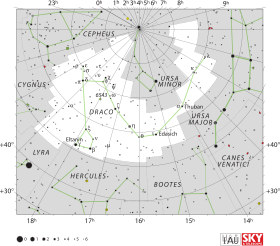Gliese 742
| Ascension droite | 19h 00m 10,2534s[1] |
|---|---|
| Déclinaison | +70° 39′ 51,418″[1] |
| Constellation | Dragon |
| Magnitude apparente | 13,2[2] |
Localisation dans la constellation : Dragon | |
| Type spectral | DAP4.5[3] |
|---|---|
| Indice B-V | +0,05[2] |
| Mouvement propre |
μα = +85,774 mas/a[1] μδ = +505,050 mas/a[1] |
|---|---|
| Parallaxe | 77,652 5 ± 0,031 7 mas[1] |
| Distance | 12,877 9 ± 0,005 3 pc (∼42 al)[1] |
Désignations
Gliese 742 (Gliese-Jahreiss 742) est une naine blanche située à 42 années-lumière de la Terre[1], dans la constellation du dragon. Avec une magnitude apparente proche de 13, elle n'est observable qu'à l'aide d'un télescope.
Propriétés modifier
Bien qu'elle ait été photographiée dès la fin du XIXe siècle dans le cadre du projet Carte du Ciel, elle n'a pas été identifiée en tant que naine blanche avant d'être observée par Gerard Kuiper en 1934[4]. Cette observation en fit la cinquième ou sixième naine blanche découverte[5]. Son spectre fut d'abord considéré comme pratiquement sans trait remarquable[4], mais de nouvelles observations montrèrent qu'il avait des bandes d'absorption inhabituellement larges et peu marquées[6],[7].
En 1970, quand des astronomes ont observé que la lumière émise par cette étoile était circulairement polarisée, elle devint la première naine blanche connue avec un champ magnétique[8]. Dans les années 1980, des astronomes comprirent que les bandes d'absorption inhabituelles pouvaient être expliquées comme des bandes d'absorption de l'hydrogène, décalées par effet Zeeman[9],[10],[11].
Notes et références modifier
- (en) Cet article est partiellement ou en totalité issu de l’article de Wikipédia en anglais intitulé « Gliese 742 » (voir la liste des auteurs).
- (en) A. G. A. Brown et al. (Gaia collaboration), « Gaia Data Release 2 : Summary of the contents and survey properties », Astronomy & Astrophysics, vol. 616, , article no A1 (DOI 10.1051/0004-6361/201833051, Bibcode 2018A&A...616A...1G, arXiv 1804.09365). Notice Gaia DR2 pour cette source sur VizieR.
- (en) Nearby Stars, Preliminary 3rd Version (Gliese+ 1991), « Gl 742 », sur la base de données VizieR, Centre de données astronomiques de Strasbourg.
- (en) LAWD 73 -- White Dwarf sur la base de données Simbad du Centre de données astronomiques de Strasbourg.
- Two New White Dwarfs of Large Parallax, G. P. Kuiper, Publications of the Astronomical Society of the Pacific 46, #273 (octobre 1934), p. 287–290.
- L'étoile EGGR 37 était suspectée d'être une naine blanche en avril 1934 (Some new members of the Hyades cluster, P. J. van Rhijn and J. J. Raimond, Monthly Notices of the Royal Astronomical Society 94 (avril 1934), p. 508–518, at p. 517) mais cette hypothèse n'a été pas été confirmée avant 1938 (Zwei weiße Zwerge unter den physischen Hyadenmigliedern, Jöran M. Ramberg, Astronomische Nachrichten 265 (mai 1938), p. 111–112; voir aussi List of Known White Dwarfs, Gerard P. Kuiper, Publications of the Astronomical Society of the Pacific 53, #314 (août 1941), p. 248–252).
- Annual Report of the Director of the Mount Wilson Observatory (1937-1938), Walter S. Adams and Frederick H. Seahes, Mount Wilson Observatory Annual Report 10 (1938), p. 1–40, p. 28;
- Studies of the White Dwarfs. I. Broad Features in White Dwarf Spectra, Jesse L. Greenstein and Mildred S. Matthews, Astrophysical Journal 126 (juillet 1957), p. 14–18.
- Discovery of Circularly Polarized Light from a White Dwarf, James C. Kemp, John B. Swedlund, J. D. Landstreet, and J. R. P. Angel, Astrophysical Journal 161 (août 1970), p. L77–L79.
- Further identifications of hydrogen in Grw +70°8247, Jesse L. Greenstein, Ronald J. W. Henry, and R. F. O'Connell, Astrophysical Journal 289 (15 février 1985), p. L25–L29.
- The optical spectrum of hydrogen at 160-350 million gauss in the white dwarf Grw +70°8247, J. R. P. Angel, James Liebert, and H. S. Stockman, Astrophysical Journal 292 (1er mai 1985), p. 260–266.
- A centered dipole model for the high field magnetic white dwarf GRW +70°8247, D. T. Wickramasinghe and Lilia Ferrario, Astrophysical Journal 327 (1er avril 1988), p. 222–233.
